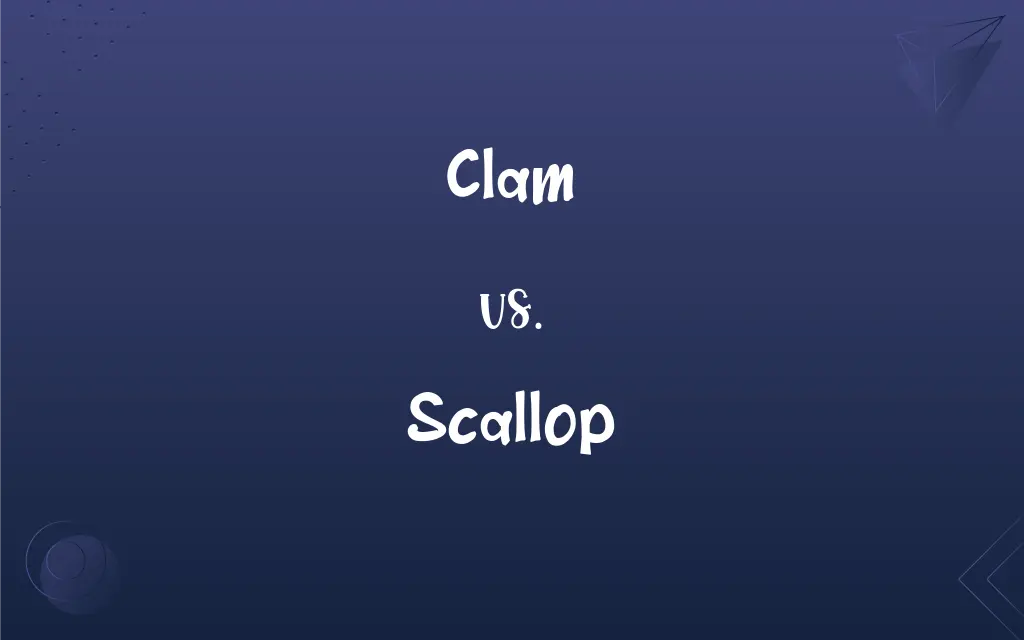Clam vs. Scallop: What's the Difference?
Edited by Harlon Moss || By Janet White || Updated on October 7, 2023
A clam is a bivalve mollusk with a tight-fitting shell, while a scallop is another bivalve known for its fan-shaped shell and ability to swim.

Key Differences
Both clams and scallops are part of the bivalve family, living within the confines of two shells connected by a hinge. Clams possess shells that fit tightly together, and they are typically dug from the sand or mud where they bury themselves. Their method of movement is largely limited to extending a foot and dragging their body along.
Contrarily, scallops are distinct with their fan-shaped, often brightly colored shells. Unlike clams, scallops have dozens of tiny eyes lining their mantle, allowing them to detect changes in light and movement. Their mode of movement is unique; by clapping their shells together, scallops can propel themselves through the water, an ability not seen in clams.
Nutritionally, both clams and scallops provide a range of benefits, being rich in protein and offering various vitamins and minerals. However, while both are consumed worldwide, their textures and flavors differ. Clams often have a chewier consistency, while scallops are known for their tender, delicate meat.
Another differentiator is their habitat. Clams can be found both in freshwater and saltwater environments, depending on the species. Scallops, on the other hand, are exclusively marine creatures, residing in oceans around the world. Both play crucial roles in their respective ecosystems, filtering water and serving as prey for various predators.
Comparison Chart
Shell Shape
Tight-fitting shells
Fan-shaped shells
ADVERTISEMENT
Movement
Extends foot to drag body
Propels by clapping shells
Eyes
Typically none visible
Dozens of tiny eyes along the mantle
Habitat
Freshwater and saltwater
Exclusively marine
Texture when cooked
Chewier
Tender and delicate
Clam and Scallop Definitions
Clam
Often buried in sand or mud.
She found a clam buried just beneath the surface.
ADVERTISEMENT
Scallop
Known for its ability to swim by clapping its shells.
I was fascinated watching the scallop move in the aquarium.
Clam
Can live in both freshwater and marine environments.
Freshwater clams are common in many lakes.
Scallop
Has multiple tiny eyes along its mantle.
The eyes of the scallop help it detect light and movement.
Clam
Known for its chewy texture when cooked.
The clam meat in this dish is perfectly tender.
Scallop
Renowned for its tender meat in culinary dishes.
The chef prepared the scallop to perfection.
Clam
Any of various usually burrowing marine and freshwater bivalve mollusks chiefly of the subclass Heterodonta, including members of the families Veneridae and Myidae, many of which are edible.
Scallop
A bivalve with a distinct fan-shaped shell.
The scallop dish was served with a lemon butter sauce.
Clam
The soft edible body of such a mollusk.
Scallop
Primarily found in marine environments.
Divers often search for scallops on the ocean floor.
Clam
(Informal) A close-mouthed person, especially one who can keep a secret.
Scallop
Any of various marine bivalve mollusks of the family Pectinidae, having fan-shaped shells with a radiating fluted pattern.
Clam
(Slang) A dollar
Owed them 75 clams.
Scallop
The edible adductor muscle of a scallop.
Clam
A clamp or vise.
Scallop
A shell of a scallop, or a dish in a similar shape, used for baking and serving seafood.
Clam
To hunt for clams.
Scallop
One of a series of curved projections forming an ornamental border.
Clam
A bivalve mollusk of many kinds, especially those that are edible; for example pl=s (Mya arenaria), hard clams (Mercenaria mercenaria), sea clams or hen clam (Spisula solidissima), and other species. The name is said to have been given originally to the Tridacna gigas, a huge East Indian bivalve.
Scallop
See escalope.
Clam
Strong pincers or forceps.
Scallop
To edge (cloth, for example) with a series of curved projections.
Clam
A kind of vise, usually of wood.
Scallop
To bake in a casserole with milk or a sauce and often with bread crumbs
Scalloped potatoes.
Clam
A dollar.
Those sneakers cost me fifty clams!
Scallop
To cut (meat) into thin boneless slices.
Clam
A Scientologist.
Scallop
To gather scallops for eating or sale.
Clam
A vagina.
Scallop
Any of various marine bivalve molluscs of the family Pectinidae which are free-swimming.
Clam
(slang) In musicians' parlance, a wrong or misplaced note.
Scallop
One of a series of curves, forming an edge similar to a scallop shell, especially in knitting and crochet.
Clam
(informal) One who clams up; a taciturn person, one who refuses to speak.
Scallop
(cooking) A fillet of meat, escalope.
Clam
Mouth (Now found mostly in the expression shut one's clam)
Scallop
(cooking) A form of fried potato.
Clam
Clamminess; moisture
Scallop
A dish shaped like a scallop shell.
Clam
To dig for clams.
Scallop
To create or form an edge in the shape of a crescent or multiple crescents.
Clam
To produce, in bellringing, a clam or clangor; to cause to clang.
Scallop
(transitive) To bake in a casserole (gratin), originally in a scallop shell; especially used in form scalloped
Clam
To be moist or glutinous; to stick; to adhere.
Scallop
(intransitive) To harvest scallops
Clam
To clog, as with glutinous or viscous matter.
Scallop
Any one of numerous species of marine bivalve mollusks of the genus Pecten and allied genera of the family Pectinidæ. The shell is usually radially ribbed, and the edge is therefore often undulated in a characteristic manner. The large adductor muscle of some the species is much used as food. One species (Vola Jacobæus) occurs on the coast of Palestine, and its shell was formerly worn by pilgrims as a mark that they had been to the Holy Land. Called also fan shell. See Pecten, 2.
Clam
Clammy.
Scallop
One of series of segments of circles joined at their extremities, forming a border like the edge or surface of a scallop shell.
Clam
A bivalve mollusk of many kinds, especially those that are edible; as, the long clam (Mya arenaria), the quahog or round clam (Venus mercenaria), the sea clam or hen clam (Spisula solidissima), and other species of the United States. The name is said to have been given originally to the Tridacna gigas, a huge East Indian bivalve.
You shall scarce find any bay or shallow shore, or cove of sand, where you may not take many clampes, or lobsters, or both, at your pleasure.
Clams, or clamps, is a shellfish not much unlike a cockle; it lieth under the sand.
Scallop
One of the shells of a scallop; also, a dish resembling a scallop shell.
Clam
Strong pinchers or forceps.
Scallop
To bake in scallop shells or dishes; to prepare with crumbs of bread or cracker, and bake. See Scalloped oysters, below.
Clam
A kind of vise, usually of wood.
Scallop
One of a series of rounded projections (or the notches between them) formed by curves along an edge (as the edge of a leaf or piece of cloth or the margin of a shell or a shriveled red blood cell observed in a hypertonic solution etc.)
Clam
Claminess; moisture.
Scallop
Edible muscle of mollusks having fan-shaped shells; served broiled or poached or in salads or cream sauces
Clam
A crash or clangor made by ringing all the bells of a chime at once.
Scallop
Thin slice of meat (especially veal) usually fried or broiled
Clam
To clog, as with glutinous or viscous matter.
A swarm of wasps got into a honey pot, and there they cloyed and clammed Themselves till there was no getting out again.
Scallop
Edible marine bivalve having a fluted fan-shaped shell that swim by expelling water from the shell in a series of snapping motions
Clam
To be moist or glutinous; to stick; to adhere.
Scallop
Decorate an edge with scallops;
The dress had a scalloped skirt
Clam
To produce, in bell ringing, a clam or clangor; to cause to clang.
Scallop
Form scallops in;
Scallop the meat
Clam
Burrowing marine mollusk living on sand or mud
Scallop
Fish for scallops
Clam
A piece of paper money worth one dollar
Scallop
Shape or cut in scallops;
Scallop the hem of the dress
Clam
Flesh of either hard-shell or soft-shell clams
Clam
Gather clams, by digging in the sand by the ocean
Clam
A bivalve mollusk with tight-fitting shells.
We dug for clams at the beach during low tide.
Clam
Consumed as seafood worldwide.
The clam chowder at this restaurant is exceptional.
FAQs
Which is sweeter, clam or scallop meat?
Scallop meat is generally considered sweeter and more delicate.
How do clams protect themselves from predators?
Clams bury themselves in sediment and close their shells tightly.
Do clams have a heart?
Yes, clams have a simple heart that circulates blood.
Why do scallops have so many eyes?
Their eyes help detect light and movement, aiding in their survival.
How do clams filter water?
Clams draw in water through siphons, filtering out particles for food.
Can clams see?
Most clams don't have eyes like scallops, but they can sense light and dark.
Are both clams and scallops considered shellfish?
Yes, both clams and scallops are types of shellfish.
Are scallop shells symmetrical?
Yes, scallop shells are roughly symmetrical.
Is it true scallops can "jump" off the sea floor?
Yes, scallops can propel themselves by clapping their shells.
How do clams and scallops reproduce?
Both release eggs and sperm into the water, where fertilization occurs.
What do clams feed on?
Clams filter feed on plankton and other tiny organisms.
Are clams and scallops good for health?
Both are nutritious, offering protein, vitamins, and minerals.
Why are scallops often more expensive than clams?
Scallops are often hand-harvested by divers, making them more labor-intensive.
Can you eat the entire scallop?
Typically only the muscle is eaten, but other parts can be consumed.
Are scallops harvested sustainably?
It varies, but many places have regulations to ensure sustainable scallop harvesting.
How fast can a scallop swim?
While not very fast, they can quickly jet short distances to escape predators.
Can people with shellfish allergies eat clams or scallops?
No, those with shellfish allergies should avoid both clams and scallops.
How long can scallops live?
Some scallops can live up to 20 years, depending on the species.
How can you tell if a clam is alive?
A live clam's shell will be tightly shut, or it will close when tapped.
Do clams and scallops have brains?
They have simple nerve ganglia, not complex brains like mammals.
About Author
Written by
Janet WhiteJanet White has been an esteemed writer and blogger for Difference Wiki. Holding a Master's degree in Science and Medical Journalism from the prestigious Boston University, she has consistently demonstrated her expertise and passion for her field. When she's not immersed in her work, Janet relishes her time exercising, delving into a good book, and cherishing moments with friends and family.
Edited by
Harlon MossHarlon is a seasoned quality moderator and accomplished content writer for Difference Wiki. An alumnus of the prestigious University of California, he earned his degree in Computer Science. Leveraging his academic background, Harlon brings a meticulous and informed perspective to his work, ensuring content accuracy and excellence.































































